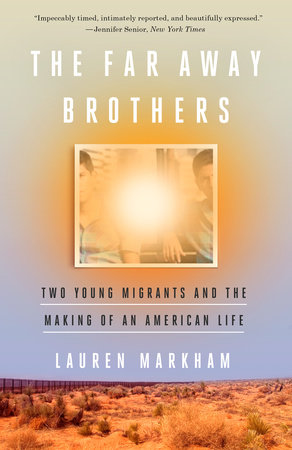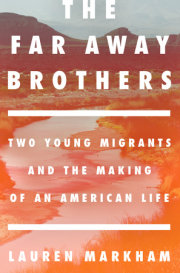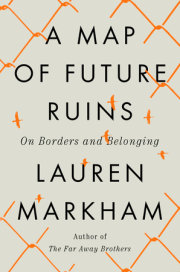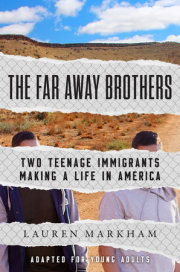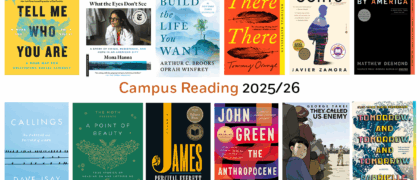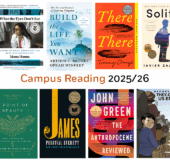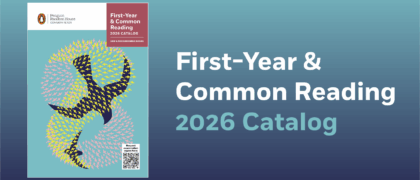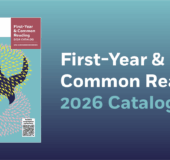Author’s Note
In the winter of 2013, I received an assignment from the
Virginia Quarterly Review (VQR) to travel to South Texas and write about the recent uptick in immigration by unaccompanied minors and what happened to them once they’d made it into the United States. These were children, mostly from Central America, who had crossed the border without papers or parents. I spent that spring reporting the story, digging into the massive infrastructure of apprehending, detaining, caring for, and litigating the cases of these thousands of young migrants who, that year, more than tripled their historical annual average. The article, “First the Fence, Then the System,” came out that June.
Since 2006, I’d been working with refugees and immigrants in Oakland, California, at various nonprofit agencies and then the Oakland school district. In 2011 I started working at Oakland International High School, a school for newly arrived English-language learners, where I coordinated programs for students and families, such as parent classes, after-school programs, and health and mental health services. Our school had enrolled a few unaccompanied minors over the years, but I understood little about their circumstances and even less about their experiences navigating the immigration system.
In the
VQR story, I had focused on the children who were caught, but I soon found myself chasing another story: what happened to the children who
weren’t caught? My story on the growing number of unaccompanied minors working in the California agricultural system, “The Lost Boys of California,” was published in
VICE in March 2014.
Just as I was filing the first draft, Mr. David, a co-worker at Oakland International, came into my office to tell me that “we really need to do something about all the kids with upcoming court dates.”
What? He explained that a number of our new ninth and tenth graders had been ordered to appear in immigration court in the coming months. The students, who were undocumented and had been apprehended by the authorities after crossing the U.S. border, were almost universally unaccompanied minors, or “unaccompanied alien children.” They had all been ordered deported and would have to fight in court for the right to stay. They were terrified of court; none of the students David had spoken to had a lawyer. Of the twenty-five or so students he advised, seven were unaccompanied minors.
While I had been away reporting on the issue outside Oakland, this population had been surging at my school, the place where I spent four days a week, right under my nose. By spring of 2014, more than sixty unaccompanied minors had enrolled at Oakland International High School, out of a student body of just under four hundred. By the following fall, the number surpassed ninety. In 2017, unaccompanied minors make up over a quarter of Oakland International’s student population.
After my conversation with David, I spent many an afternoon shepherding kids to pro bono legal agencies and court dates and setting up intake appointments and “know your rights” information sessions at the school. The students needed counseling and tutoring and doctors’ appointments; some of them needed help finding homeless shelters and access to food and clothing. Supporting unaccompanied minors quickly became one of my primary responsibilities.
In February 2014, I met the Flores twins. (To protect the anonymity of the “Flores” family, I have changed their names and those of many others who appear in this book, as well as the name of their hometown.)
They told me why they had come, but I had so many more questions. What were these children really risking—and enduring—to come here, and what was the likelihood they would gain the right to stay? Would they really be better off if they did? Were the stories I was hearing overblown, and could I take their reasons for coming to the United States at face value? Answering these questions became a personal imperative, one that would help me better understand my students, my country, and the endless churn of southern migration into the United States.
To learn more about the Flores family’s story, and that of the hundreds of thousands of migrants like them, I traveled to El Salvador, Mexico, Guatemala, and Texas, reporting from various fulcrums of violence in El Salvador as well as at stations along the migrant trail north. Parts of this book I witnessed myself, and other parts have been reconstructed through extensive reporting and interviews, all in service of investigating the changing dynamics of migration.
Since reporting that first article for
VQR, I have heard countless stories from young people traveling alone to reach the United States. Every story is different, but there are also striking similarities, often having to do with mounting violence in the children’s home countries. These girls and boys are crossing into the United States in search of the fabled “better life” that has attracted migrants, authorized and unauthorized, since before the
Mayflower landed. But in the Northern Triangle—Honduras, Guatemala, and El Salvador—a “better life,” for many, means a life where they are not afraid of being killed.
I began reporting this book during the Obama administration, a time rife with anxiety for undocumented migrants. It was completed after the election of Donald Trump, marking an era of unprecedented fear among immigrants and refugees past and present. In a time when immigration is in the daily headlines yet is too often reduced to a matter of binary politics—keep them out or let them in, wall or no wall—this book seeks to offer a complex understanding of why immigrants leave their country, what struggles they endure to get here, and the challenges they face setting roots in a foreign land.
The story of the Flores twins isn’t the most harrowing, or the most unjust, or the most extraordinary I’ve come across as an educator and a journalist—far from it. But something in their story illustrates, roundly and heartbreakingly, the wounds of war, the spirit of a new generation of immigrants, and the impact of migration on the United States as well as on the tiny, time-battered country of El Salvador.
The United States is still young and is ever reiterating itself as demanded by its people, both those who have lived here for a long time and those who have just arrived. Immigrants have always shaped our country’s future. Young Central Americans are coming here in unprecedented numbers, and how they are or are not received and supported will determine, in part, the next chapter in the American story.
“For a child to choose to make that journey,” an advocate told me during my first trip to South Texas, “there’s a reason.”
Since 2012, hundreds of thousands of minors, paperless and parentless, have crossed into the United States. “Why are they coming, and why so many?” I wrote in my first piece on unaccompanied minors. It was an earnest question. Every answer raised another question, and the result is this book. It is about who these young men and women are, where they come from, the choices they’ve made, and what their stories reveal about who we are as a country, and what we will, or might, become.
Chapter 1
“You boys from eighteen?” one of the young men said, pointing his gun toward the retaining wall marked by a small graffito tag: barrio 18.
It was 2008. The Flores twins, twelve, were playing poker on the town soccer field with their older brother and six friends when the pickup pulled up. Ten or so guys stood in the truck bed brandishing guns and machetes, sporting hip-hop clothes and tattoos. They were MS-13, or Mara Salvatrucha, the twins knew—members of the gang that was then slinking into the small town of La Colonia. The Flores boys and their friends were high on adrenaline from having won a big soccer match that morning, a feeling that mixed nicely with the bravado of early adolescence. But the sight of the armed men scared them silent.
They shook their heads no.
“I asked you a question!” barked the guy in the truck.
Ernesto’s gaze was lowered, but he could feel the men staring down at him. “I asked if you f***ers were from eighteen!” the man shouted. At that, one of their friends took off running into the woods. Suddenly— they couldn’t remember who moved first—the twins were sprinting through the forest that flanked the town soccer field, Ernesto first, Raúl close behind, panting and flying over dips and gullies, pushing past banana trees and crashing through the tall grasses while shouts and a scatter of gunshots crackled behind them.
Running away from a truck of gangsters was either an admission of guilt (in this case, allegiance to the rival Barrio 18 gang) or, at the very least, a sign of a lack of respect for MS-13 authority.
When the shouts felt far enough away, the twins hit the ground, lying on their bellies in the brush. They stayed there for what felt like several hours—until they were sure the truck was gone. They were too scared to go back to the field and look for their cards, which, for anyone
vigilando, or keeping watch over the area, might tag the twins as the ones who ran. For a while, at least, no more poker.
---
The road to La Colonia is meandering but smooth, thanks to the scant traffic. It weaves through a tangle of greenery: vines overhang concrete walls alongside tall, tight rows of banana trees, diaphanous canopies of
barillos, pink flowering cacao, dense
cedro negro, and flushing palms. The road begins in a valley and winds upward to where La Colonia, about thirty miles from San Salvador and home to fewer than four thousand people, spreads up and around the slopes of a gentle, low hill.
The houses along the road are simple but comfortable, built from concrete, many of them painted colors that were once bright—ice blue, cotton candy pink, white with fuchsia trim—but that now, with weather and time and dust, have faded. Less fortunate homes speckle back into the adjacent hills and farmland. Flags of the conservative ARENA party flap from electric poles and appear painted on buildings. Along the road stand La Colonia’s schools—two high schools and an elementary school. One of only about a dozen Flores family photos is of the twins and their older sister, somber-faced and gangly beneath too-big dress clothes, on the proud occasion of their ninth-grade graduation.
Cows use the road as often as people do, lashed together by the horns and plodding along between farm and pasture, and dogs warm themselves in the middle of the street looking like splayed corpses. At the sound of approaching cars they rise, shake themselves, and lumber off to where the road turns to dirt. During harvest time, families turn the two-lane road into one as they lay their bean pods and corn out to dry, the kernels spread like a blanched mosaic along the tarmac.
The road crests the hill and begins to dip downward, and that’s where the Flores home sits, a stone house lined with crumbling stucco. From there it’s not much farther to the center of town, a sleepy square rimmed by a block or two of houses and a few businesses—family-run restaurants, sundries shops, the mayor’s office. The high-rising church is the town’s main attraction, its tower wielding a hulking cross that casts a daily shadow into the central square. At noon the church bells chime.
Until the twins were teenagers, the town center was frequented day and night. Kids ran around the small playground, people took refuge on the shaded benches, and boys played soccer on the open concrete court, even in the afternoon heat. People came to use the copy shop or buy soap or soda or enter a complaint at the mayor’s office. Children who’d begged spare change from their parents bought snow cones from the heavyset woman with the mobile stand, the bright, tacky syrup staining their faces. The
pupuserías were open until eleven, midnight even, playing music and serving sodas and beers, the lady proprietors flipping the cakes of corn masa against the griddle until the edges were crispy yellow-brown.
“It was a beautiful town,” Raúl remembers. “It was.”
---
Like the rest of the farmers in La Colonia, the twins’ father, Wilber, regarded the mountain and its fertile land as a divine inheritance. The land was good to him; God provided. This was Wilber’s credo. “The way to survive this world is to stay close to God,” he said to his children. “And keep
manos limpias”: clean hands.
Wilber carried a small Bible in his pocket at all times, the binding frayed and worn from use. Tucked inside were several prayer cards, his Salvadoran national ID, the photo taken when he was a very young man, and a picture of his bride, Esperanza, now faded and tattered. Every now and then he’d pull out the keepsakes to have a look.
“See how young you were!” he’d say. Esperanza tittered like a girl, waving her hand as if shooing a fly.
Wilber and Esperanza had always wanted a big family, but for many years they’d felt they might be cursed. They got married in the midst of the country’s civil war, in 1985, and when Esperanza gave birth to her first baby, Ricardo, two years later, the war still raged. La Colonia wasn’t a hot zone, but soldiers marched through it on occasion. This never meant anything good for poor farmers like the Flores family, whom the government often suspected of being guerrillas. “The soldiers came looking for people,” Esperanza explained. “They could mistake you for someone else and punish you for something they did.”
Once when Wilber was out of town working on another farm’s harvest, news spread that the army was on its way. Esperanza snatched up Ricardo, who was barely a year old, and walked out of town up into the hills, where she stayed along with some neighbors for a couple of days, hoping Ricardo didn’t cry too loudly. The army passed through without fireworks or massacres. Esperanza came down from the mountain, and they resumed their lives at home.
It was a dirty war, as Wilber put it—a war between the rightist government, beholden to the country’s powerful oligarchy and operating with brute military force, and the mounting leftist guerrilla movement, fighting for the interests of the impoverished working class, especially the country’s rural farmers. But the Flores family thought it best to stay out of politics.
In cities and in the countryside, mutilated bodies showed up in the streets. Political prisoners—dead and alive—were heaved off the Devil’s Gate cliff in the dense hills above San Salvador. Both sides played dirty, but the government death squads were brutal: a UN-appointed truth commission report asserts, with some contestation from within El Salvador, that 85 percent of the atrocities were carried out by the government. In the early 1980s, the United States trained and backed the government forces—death squads and all—to prevent a guerrilla takeover: an effort, in the thick of the Cold War, to prevent the proximal spread of Communism.
“It was a terrible time,” Wilber says. He won’t say much else about the war.
In 1988, as the violence heated toward its final boil, Esperanza gave birth to another son: Wilber Jr. Then, as peace negotiations were under way in Mexico City, she gave birth to a daughter who died at just several weeks old. They buried her in La Colonia. Esperanza kept praying for more children, placing offerings upon the altar and asking God and the Mother Mary for their blessings every Sunday in church. The peace accords were signed in Mexico City in 1992, and as the government and the guerrillas agreed to lay down their weapons for good, Esperanza got pregnant again. This baby, too, died at just several weeks old, and another after that made it only a few days before she turned blue and they had to bury her as well. Was Esperanza cursed? Was she too old?
In 1994 El Salvador held its first free and fair peacetime elections. The conservative ARENA party won, but the war was over. After so many years of conflict, it was a time of rebuilding. That year Esperanza’s prayers were answered: she gave birth to her sixth child, a girl, Maricela. Maricela lived.
The Flores family were still farmers who scraped by harvest to harvest, who struggled to find money to buy clothes or take a child to the doctor. But as Esperanza looked back, she regarded those as good years: three healthy babies, a country out of war.
Then the curse reared again: another baby, who died another mysterious death just a few weeks after he was born. That made seven children in all, only three of whom had made it to a year. In a place with little medical care, tragedies like this were common enough, but four tested Esperanza’s faith. At the end of 1995, when her belly began to swell again a few months after the fourth baby died, she prayed she wouldn’t lose this one, too.
After a bit of nausea early on, she had a good feeling—this one, she thought, would keep. The closest doctor was a thirty-minute drive away, and anyway, she couldn’t afford him. Prayer was more important, she felt in the end. Within just three months she was bigger than she’d ever been at that stage. By month five she was exhausted, walking wide-legged, having to heave herself out of the bed each morning to feed the children and scatter corn for the chickens. She’d squat to tug at the cow’s udders for milk, her back aching, her knees on fire.
Wilber prayed for her at church, crooned hymns and strummed the guitar in the front of the congregation. He worried that the bigness and the fatigue were due to her age, mid-thirties, so he put more offerings onto their altar—corn, beans, flowers from the blooming trees, and vines around their house, a plump orange, a twin tomato. God was good. He’d let them keep this one.
“Look how big I am!” Esperanza boasted. Must be a boy, some neighbors said. She was eating so well after the year’s good harvest. Maybe she was further along than she thought?
Esperanza had her own quiet suspicions. She didn’t want to jinx it, but she thought she might be carrying two. It wasn’t just the taut globe of her belly; she had a warm, warbling sense of it in her heart.
They saved up some money. When it neared her time to give birth, she took the bus down to the hospital, where they listened to her stomach and brought a picture onto the screen.
“Twins,” the nurse said.
She’d been right. There were two little bodies, the thump of two heartbeats. Fifteen days later she went into labor. Ernesto slipped into the world first, screeching. She felt relief and then a wild need to push again. She labored the other baby out twelve minutes later—Raúl. Two identical creatures, writhing, their brown-pink bodies slick with birth. The nurses brought them both into her arms. They’d make it, she thought.
Copyright © 2017 by Lauren Markham. All rights reserved. No part of this excerpt may be reproduced or reprinted without permission in writing from the publisher.

